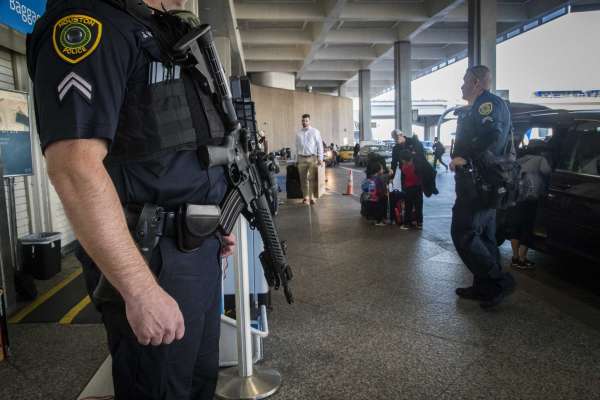Human trafficking is an overwhelmingly huge epidemic. With 40.3 million victims worldwide, it is easy to feel like there is no possible way to do anything to help solve the problem of human trafficking (“The Facts”). In a way, this is correct; human trafficking will never be completely solved. There are just too many victims and traffickers for the problem to be completely solved, but people can do something. The idea of curbing human trafficking is a daunting one, but the enormous size of the epidemic shouldn’t stop someone from trying to make a difference. There are several things regular people and government officials can do to impact the human trafficking epidemic; here are a few.

One way to curb human trafficking would be to strengthen the security at airports and other human trafficking hubs and hotspots. Bus stops and airports are very important to human traffickers, as they are used to transport their victims from place to place quickly. With this being said, Georgia is home to the busiest airport in the world, the Hartsfield-Jackson Atlanta International Airport (Parker). This airport is one of the main reasons why Atlanta is one of the biggest human trafficking hotspots in the United States. Once victims leave a bus stop or airport, they are often never seen again, becoming nearly impossible to rescue or even trace (Pylidis). The best way to deal this problem is increased airport security. A higher minimum number for airport security officers would guarantee that every airport has more security than they have now. With increased airport security, human trafficking victims could be saved before they completely disappear.

Another way anyone could help curb the human trafficking epidemic is to learn how to identify a human trafficking victim. As the numbers prove, human trafficking victims are everywhere. The tragic fact is that people see victims all the time in everyday life, but don’t know that they are victims. Rose Pylidis states that identifying victims is not as difficult as many people think it is, and simply “paying attention to anything out of the ordinary” could save a human trafficking victim from a life of forced slavery. She continues to list several ways people who frequently travel can identify victims in an airport. She advises frequent travelers observe what people are wearing; human trafficking victims are often dressed strangely. Victims are often wearing clothes that don’t properly fit, or clothes that appear ragged and low-quality. In addition to wearing low-quality clothing, victims are often dressed differently from their traffickers who they travel with (Pylidis). Unsurprisingly, victims may have bruises and look malnourished, as many traffickers are physically abusive.
A victim may also have strange tattoos, as some traffickers like to brand their victims as a way of asserting dominance over their victim (Pylidis). Another way to identify a victim is to look for a trafficker. Oftentimes, the trafficker is travelling right beside their victim, and the trafficker shares no resemblance to their victims (Pylidis). Two people travelling who don’t seem to be related or even friends can be a serious red flag; watch these people closely. If you suspect someone may be a human trafficking victim, approaching them and personally talking to them is a great way to gather more information. When talking to a victim, they often seem uncomfortable, and speak as if they are reading from a script (Pylidis). It is common for traffickers to “coach their victims to say certain things to avoid suspicion” (Pylidis). It is also common for victims to withhold important information, like where they are from and where they are going (Pylidis). This is information that a trafficker wants to keep a secret. Sometimes, when a victim is questioned they will divert the conversation to their trafficker, who is more than likely prepared to tell a convincing lie to hide the identity of themselves and their victim. This is a lot of information, but it is all very important. Knowing how to spot and identify a human trafficking victim can save them from a life of pain and misery.
Another group that can have a significant impact on identifying human trafficking victims is nurses. Nurses that work with children can be essential in identifying child human trafficking victims. Patricia Normandin writes that “Emergency nurses can pull the threads of child human trafficking by empowering themselves with education.” In her article on human trafficking among children, she details several ways emergency nurses can identify child victims. Most of the identifying factors Normandin lists in her article are very similar or identical to the ones Pylidis lists in her article on human trafficking, detailed earlier in this post.
Normandin advises nurses to examine children and their guardians if they suspect human trafficking. She warns that if the child and guardian in question do not appear related, the guardian could potentially be a trafficker (Normandin). Questioning a child suspected to be a human trafficking victim can also be essential to identifying the child as a human trafficking victim. If a child cannot answer basic questions like what day or time it is, or cannot give their home address, they could be a trafficking victim (Normandin). Something else to watch out for; children avoiding questions related to their physical injuries. Normandin writes that if a child is avoiding questions related to their physical injuries it could be a sign that they are being trafficked (Normandin). All of this information can be used to identify child human trafficking victims, saving them from living a life of pain and abuse. If they can learn the identifying signs, nurses can make a real difference, identifying and saving the most vulnerable and helpless human trafficking victims before it’s too late.

A key step that needs to be made in order to more effectively solve the human trafficking problem is increased research of the topic. In Blog Post #4, I referenced Kiss and Zimmerman’s article “Human trafficking and labor exploitation: Toward identifying, implementing, and evaluating effective responses,” which details how we know very little about human trafficking. In the article, they report that research on human trafficking prevention “is still in the early stages” (Kiss and Zimmerman). This quote shows us that the status quo regarding research on human trafficking prevention needs to change, as the evidence is insufficient for proposing an effective solution. If the government is going to make any real progress in finding a solution to the human trafficking epidemic, they need to focus their attention and resources on extensive research of the issue. The government can’t begin to try to solve a problem they still know very little about.
In order to save more victims and catch more traffickers, the government needs to do more. As of right now, the government is doing a terrible job at curbing human trafficking, as proved by an article published by the Department of Homeland Security’s official website. The article explains how it took four government agencies, a Task Force, and “multiple state/local law enforcement agencies” 15 months to catch a measly 29 traffickers and identify even fewer victims (“ICE arrests 29 people…”). These numbers are extremely low, especially when compared to the total number of human trafficking victims. In order for the government to be more effective, they need to heighten their focus on the human trafficking epidemic. They need to make their existing programs and agencies more effective via increased funding and manpower. The status quo can change, but it can’t happen without the government’s support and involvement.

The road to finding an effective solution to the human trafficking epidemic is a long, hard, complicated one. There are several steps that need to be taken in order to really make a difference, and some of those steps cannot be taken without the government’s assistance. Of course, most people do not have powerful government jobs, but most of us know how to write, and even more of us can speak. We, the free people of the United States, need to take a stand for human trafficking victims by spreading awareness of the issue. We can do this by writing blogs, writing the government, and simply telling friends and family about the epidemic. Human trafficking is a huge issue, and most people have no idea of how big it really is. Let’s make a difference by being a voice for people who can’t speak. Together, we can fight to end the human trafficking epidemic, one word at a time.
Works Cited:
“ICE Arrests 29 People in 8 States on Human Trafficking Charges, Identifies 15 Potential Victims, Following Multistate Undercover Investigation.” ICE, 30 Oct. 2015, www.ice.gov/news/releases/ice-arrests-29-people-8-states-human-trafficking-charges-identifies-15-potential.
Kiss, Ligia, and Cathy Zimmerman. “Human trafficking and labor exploitation: Toward identifying, implementing, and evaluating effective responses.” PLoS Medicine, vol. 16, no. 1, 2019, p. e1002740. Gale In Context: Opposing Viewpoints, https://link-gale-com.libproxyl.ggc.edu/apps/doc/A571883909/OVIC?u=ggcl&sid=OVIC&xid=38ae064f. Accessed 4 Sept. 2019.
Normandin, P. A. (2017). Child Human Trafficking: JEN JEN. Journal of Emergency Nursing, ee, Pull, Cut the Threads of Abuse: 43(6), 588-590. doi:http://dx.doi.org/10.1016/j.jen.2017.07.014
Parker, Kathy. “Shining a Light on Human Trafficking in Metro Atlanta.” Bizjournals.com, 2018, http://www.bizjournals.com/atlanta/news/2018/09/28/shining-a-light-on-human-trafficking-in-metro.html.
Pylidis, Rose. “How Business Travelers Can Spot Human Trafficking In Airports.” Christopherson Business Travel, 18 Apr. 2019, www.cbtravel.com/2018/11/spot-human-trafficking-in-airports/.
“The Facts.” Polaris, 9 Nov. 2018, polarisproject.org/human-trafficking/facts